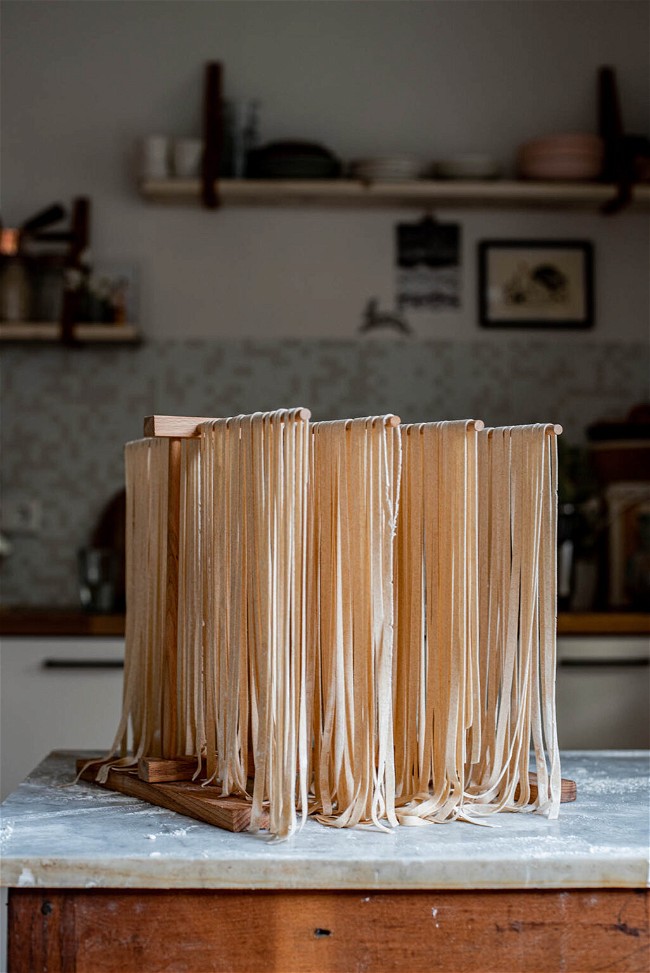Whole Spelt Past
A simple spelt pasta, made with whole grain spelt flour, a nutty ancient grain. Options for both vegan (made with water) and egg pasta.
Whole Spelt Pasta
Rated 4.3 stars by 3 users
Category
Dinner
Cuisine
Italian
Prep Time
30 minutes
Cook Time
5 minutes
A simple spelt pasta, made with whole grain spelt flour, a nutty ancient grain. Options for both vegan (made with water) and egg pasta.

Directions
Add the flour to a large bowl and make a well in the centre. Add the water. Using a fork, slowly bring the flour to the centre of the bowl and mix, always moving from the outside in.400 grams spelt flour, 200 ml water
Continue mixing until a stiff dough forms. Once the dough becomes too difficult to mix with a fork, turn it out onto a clean worktop.
Knead for about 5 minutes, or until a smooth ball of dough forms. It will feel quite hard but should be almost silky to touch.
Wrap the dough in a tea towel and cover with a bowl. Let it rest at room temperature for at least 20 minutes. Alternatively, refrigerate for up to 24 hours and bring back to room temperature before rolling.
Once the dough has rested, cut it into 4 equal pieces. Using your hands, flatten each piece to about 2cm / 1 in. thick. Generously coat the pieces in flour, then roll through the thickest setting on your pasta maker (usually 0).
Continue rolling the dough, going through the thickest setting several times, folding a few times, before moving to the next setting. Add flour to coat as needed. I usually go to number 6 before moving on to cutting, but follow your machine instructions.
Once the dough has been rolled out to the desired thickness, sprinkle the sheets with some more flour and then cut into your desired pasta shapes. Place the cut pasta onto a wooden drying apparatus while you cut the remaining sheets, or coat with a light dusting of flour and make nests to set aside.
Depending on how you’ve cut it, the pasta will need different cooking times. Generally 2-3 minutes in well-salted water at a rolling boil will do it.
To store the pasta, dry on a rack for about 24 hours, or until fully dry, and store in a sealed container for up to a month. I think it can be frozen but I’ve never tried due to lack of freezer space.
Recipe Note
All flours will absorb water differently. Depending on if I grind my own spelt or use ground from the store, for example, the amount of water I end up adding varies quite a lot. You may need to add more flour than called for to make the dough stiff enough.
If, after resting, your dough has gone from a hard ball to quite soft and slumped looking, don’t worry! Simply add more flour before starting to roll the pieces through the rollers, and add a sprinkling of flour each time you fold the long pieces over before moving to the next level of thinness. By the time you’re done it’ll be the right consistency.
The general rule for using eggs in pasta dough is one egg per 100g of flour. I find that spelt flour works a bit differently, and I use three large European eggs for this recipe. You may or may not need to add a splash of water to your dough with that.
Expert Tips
Mix it in a bowl: you can mix the dough straight on the counter, but that’s more mess than I want. Starting in a bowl reduces some of the cleanup later.
Dry it right away: if making long pasta, immediately place it onto a wooden or metal drying rack (simply make from dowels) to dry until you’re ready to cook it. Otherwise it does tend to stick together.
Don’t wait too long: fresh spelt pasta needs a couple of minutes to cook in well salted boiling water. Drain and add sauce or toppings and serve immediately. If it sits in the sieve, it will turn into a large lump. If fully dried, it needs about 12 minutes to cook.
Making Pasta Without a Machine
It’s possible! You knead and rest as usual, then roll it out with a rolling pin. Roll it out paper thin, as thin as your arms can handle! I find water based pasta a lot easier to roll than egg based. It is a lot of work, be prepared.
I use a hand pasta machine, as you can see in the photos, but you can also get electric ones that also mix the dough for you. I prefer the middle of the road option here – kneading by hand, then rolling with a machine. That being said, though, the electric ones make homemade pasta an absolute breeze.
Serve with Pasta
If you’re making your own pasta, you really must make your own sauce, too. Try a hearty lentil bolognese or easy dairy free pesto (as pictured below). If it’s in season, wild garlic pesto is the perfect accompaniment. If you don’t like saucy pasta, try a quick garlic spinach pasta instead.
